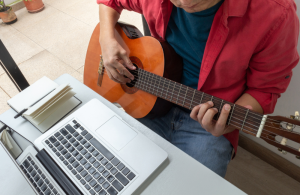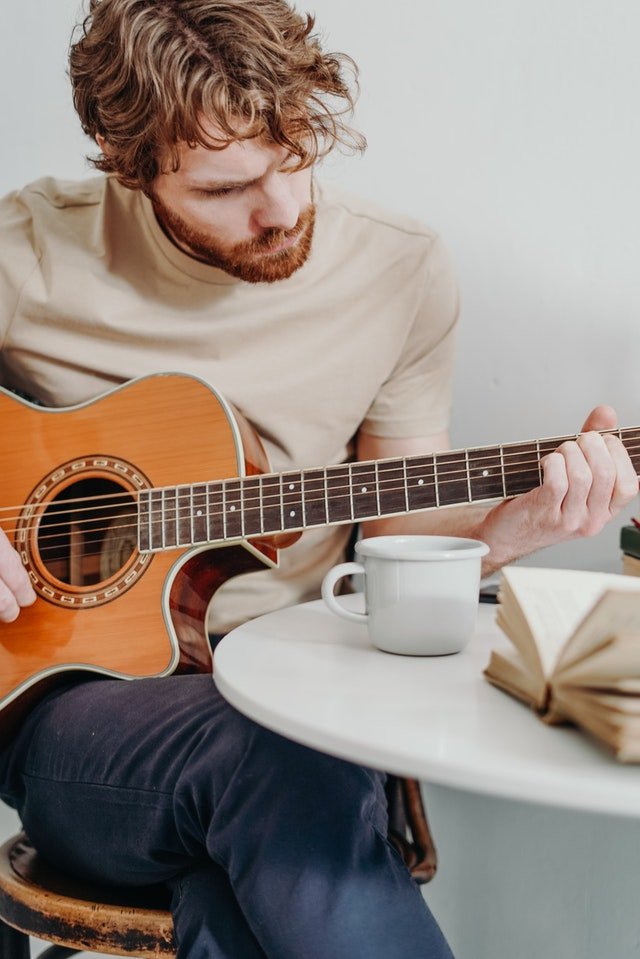
11 Best Online Guitar Courses Reviewed And Compared
What are the best online guitar courses? And how they can help you to learn the guitar? Read all you need to know about online guitar lessons and learning the guitar on your own.

If you ask how long does it take to learn the acoustic guitar, you are not alone. Every budding musician who wants to learn the guitar wants to know how long it will take. In fact, this question is a bit tricky because there are many answers to it. Experienced guitarists will tell you that learning to play the guitar takes a lifetime. Marketing managers of some guitar courses claim that you will learn to play acoustic guitar in 1 month.
In this article, I will try to explain to you what the speed of progress depends on and what its real time frames are. You will find out which factors influence how fast and efficient you will proceed. We will also add tips on how to learn to play the guitar properly and effectively. So let’s start by showing some time frames on how fast you can learn some acoustic guitar skills.
Please take these time frames with ca grain of salt. The speed of gaining new skills with acoustic guitar depends on the factors that we will discuss in the next chapter. The timeline is based on the experiences of many guitarists as well as my own.
Playing basic chords and basic strumming, and easy songs
1 – 3 months
Major, minor scales and basic music theory: 1-3 months
1 – 3 months
Blues, Country, Rock: guitar chords, scales, strumming, easy songs, and guitar riffs typical for the genre
6 – 9 months
Jazz, classical guitar: understanding elementary jazz, or classical harmony, chords, scales, riffs, rhythms
1 – 2 years
Advanced chords, scales, improvising, rhythms
2 – 3 years
It can take a few months to know how to play chords in songs. You need to get used to the chord shapes and learn the rhythmic play of the right hand. During this time, you will be able to master basic music theory.
However, if you want to know how to play blues, rock, country, or any other style of popular music, be prepared for a much longer time. In addition to guitar chords and strumming techniques, you will learn riffs, scales, and progression typical for the style. Let’s be optimistic to say you can play at an “audible level” in 6 months.
However, when we talk about jazz or classical guitar, you will need even more toughness and time. It includes more advanced knowledge of theory, superstructure chords, progressions, chord substitutions, in the case of classical music, reading notes, and playing with your right fingers.
As I said, the particular time frames are only a very rough estimate. The real time of progress will depend on your approach and the following criteria:
I intentionally start with motivation, because I consider it to be the most powerful weapon of every musician. The desire to play the guitar is very strong at first, but gradually weakens for most people. The reason is the disappointment of the slow progress or you simply lose the fancy to devote time to practice.
It is important to overcome this stage and look for a new way of perceiving music that will excite you. For example, discovering new (not only) acoustic guitar music or playing with other musicians can help.
Playing an acoustic guitar or any other musical instrument is similar to learning a foreign language. It is a long-term process that requires time, and concentration. The reward for persevering will be the joy of being able to play the music you love.

TIP: Alternate practicing with playing real music to keep yourself motivated. You can play your favorite songs and try to improvise on them. Listen to which tones and progressions fit there and try to remember them.
Right at the beginning of your musical journey, it’s a good idea to ask yourself: What do I want to achieve? What are my goals? What style do I want to know how to play? At what level?
There is a difference if you want to play popular songs around the campfire with your friends or be a guitarist in a professional country band. Therefore, it is good if you determine YOUR goals in the beginning. When you set your mind right now, you can avoid disappointment or burnout in the future.
Here are a few examples of what such a goal might look like. I want to learn:
There can be many more such specific goals. It is important to have your own in your head and take gradual steps to implement it.
TIP: Make a plan for the next 3 months. Which songs do you want to learn to play, what new chords, scales, riffs? Break down the individual tasks during these months and at the end try to evaluate to what extent you have achieved your goal.
The next task will be to find a way to achieve your goal. According to the experience of many other guitarists, it is good to turn it into small ones. Take small steps, but regularly. In practice, this means that it is better to exercise 5 times a week for 30 minutes than to play all day once every two weeks.
The reason is muscle memory and psychology. We learn by repetition, so regularity is needed even with an acoustic guitar. I mentioned psychology because if playing and practicing the guitar becomes a habit, it’s easier to follow. If learning acoustic guitar is only a marginal one-off matter, you can hardly expect any results.
TIP: Perseverance is a form of stubbornness. Try to be consistent in your efforts and even if you fall out of your rhythm of practicing, try to catch up in the next period.
Of course, how fast you progress also depends on the time you spend practicing. If you, for example, practice regularly for 30-60 minutes several times a week, you can experience hearable progress in few months.
In this context, we shouldn’t forget about the ratio of quality vs. quality. There are guitarists who “practice” 4 hours a day. They just play to the music and repeat the same mistakes. Therefore, for all beginner guitarists, I recommend attending music school for a while. You can also find an online teacher or take an online music course. It can save you from incorrect practice and lead you in the right direction.
TIP: Be patient. After a while, it may seem that you haven’t moved anywhere. Believe me, all musicians know this feeling. However, try to persevere and motivate yourself by attending a great concert.
I will now elaborate on what I outlined in the previous paragraph. There are basically 2 ways to learn to play the guitar. You are either learning from someone or yourself. For guitar newbies, I definitely recommend the first method or a combination of both.
As I said, if you don’t have time to go to music school, you can search for an online teacher (lessons via webcam) or try ready-made online guitar courses. There are dozens of them on our website. Jamplay, for example, offers dozenz of courses for acoustic guitar from excellent instructors. Truefire is another reasonable choice. Both these platforms provide online courses for acoustic guitar, fingerstyle guitar lessons, and tons of other video courses.
Whatever option you pick, it is better to get advice from experienced instructors from the beginning to avoid repeating mistakes and incorrect techniques.
If you play any other instrument, the guitar will be easier for you. This is because you already understand a lot of things about the musical structure (chords, scales, harmony, melody, rhythm, sound,…) and because you are used to the learning process. For example, if you are a bass guitarist or a ukulele player, learning the guitar will be a smooter and faster.
TIP: If you play the ukulele, or are thinking about it, read this blog of mine: Guitar Vs Ukulele – Which Musical Instrument Is Better To Start With?
When I started learning to play the acoustic guitar, my instrument was terrible. Due to the large space between the strings and the fretboard, I had finger pains after each exercise. Fortunately, nowadays there is a huge selection of acoustic guitars for beginners in various price categories. If you don’t know which instrument to choose, get advice from retailers (usually friendly and experienced guys) at a musical instrument store. You can also google the best acoustic guitars for beginners and choose the one that suits your style.
TIP: When choosing an acoustic guitar for beginners, also focus on the appropriate size, type, sound, quality of materials and price. This tutorial can also help you.
So how long does it take to learn the acoustic guitar? I hope you have come closer to the answer in this article. Learning an acoustic guitar is a process whose success depends primarily on your approach.
You are able to learn basic skills over the course of a few months. If you continue your efforts, even with small breakdowns, you will become a capable guitarist. Then not only you will enjoy your playing, but also the people who will hear you.

What are the best online guitar courses? And how they can help you to learn the guitar? Read all you need to know about online guitar lessons and learning the guitar on your own.

This Guitar Tricks Review 2021 will give you all information you need to know about this learning platform. Are these online guitar courses good for you? How does it work? Read the review and find it out.